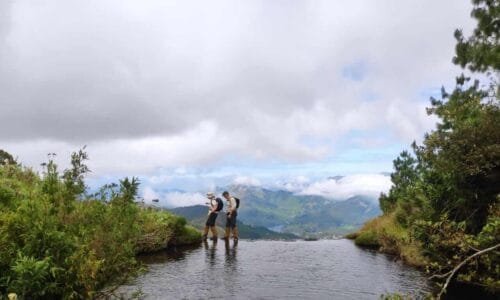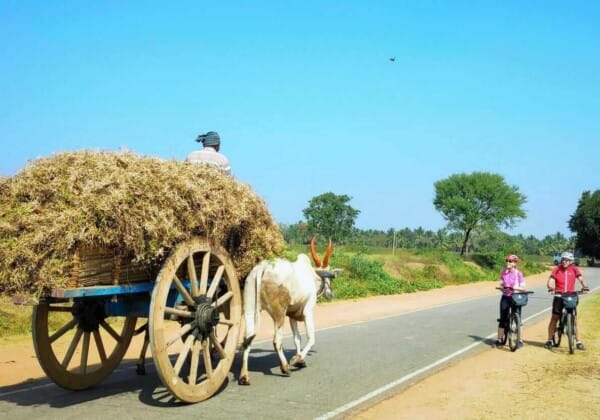World Environment Day 2025 is rallying the planet to end plastic pollution, and the clean-up begins with the way we travel. India’s national parks are already answering the call—transitioning to electric safari vehicles, banning single-use plastics and channelling tourism revenue into local conservation. Follow five greener trails that stitch together the country’s most biodiverse corridors and discover how an adventure holiday can leave a lighter footprint than ever before. (UNEP – UN Environment Programme)
Bandipur, Karnataka – the silent‐safari frontier
Dawn mist hovers over the dry deciduous forest while a herd of chital crosses the track in silence: the jeep you’re riding is electric, a pilot project that is gradually replacing diesel gypsies in many Indian reserves. Bandipur, a cornerstone of the Nilgiri Biosphere Reserve, has aligned its visitor strategy with the Ministry of Environment’s directive to “electrify” park fleets, cutting noise and tailpipe emissions that disturb wildlife. (Clean Mobility Shift) Park authorities cap each drive at three hours, enforce zone rotation and urge travellers to book well ahead to avoid crowding the core habitat. (bandipurnationalparkonline.in) Choose a lodge that bottles filtered water on site and operates garbage-recycling tie-ups with Gundlupet municipality; your stay directly funds anti-poaching patrols that now use the same quiet EVs.
Masinagudi, Tamil Nadu – communities in the elephant corridor
Just across the state border, Masinagudi sits inside the Sigur Plateau, a critical elephant migration corridor linking the Western and Eastern Ghats. Here, village-run homestays have capped room numbers, switched to rooftop solar and banned disposable plastics after a surge in litter was found to divert elephants from traditional water holes. Guides are drawn from Irula and Kurumba communities who interpret pugmarks, medicinal plants and traditional honey-gathering methods, so income stays within the corridor villages that now police their own forest edges against illegal graziers. (Wikipedia)
Uttarakhand – Corbett’s model of controlled access
High in the Himalayan foothills, Jim Corbett National Park limits vehicle entry to 180 per day and assigns strict zone quotas, ensuring that tiger sightings never come at the cost of habitat stress. (corbettpark.com) Eco-lodges have phased out single-use plastics and treat grey water for kitchen gardens. A proposal to retrofit existing safari gypsies with battery systems is under review, reinforcing Corbett’s long-running emphasis on noise-free, low-density tourism. (Wildlense, Clean Mobility Shift) Visitors are encouraged to spend an extra night in the buffer villages, where women’s cooperatives sell organic mustard oil and millet biscuits that fetch a premium over forest produce collection.
Rajasthan – Ranthambore’s push toward cleaner drives
Ranthambore’s lakeside ramparts glow amber at sunrise; soon you may glide past them in an e-safari canter. State authorities have green-lit trials that will ferry pilgrims to the Trinetra Ganesh temple and tourists on tiger drives with zero exhaust fumes. (Clean Mobility Shift) Until the fleet is fully electric, the park continues to cap daily departures and fines guides for spotlighting wildlife after dusk—a rule that conservationists routinely remind visitors to uphold. Choose tour operators who pledge to offset fuel emissions and invest in village biogas units that curb wood-fuel dependence around the reserve.
Periyar, Kerala – bamboo rafts and tribal stewardship
Periyar Tiger Reserve’s flagship bamboo-rafting programme may look leisurely, yet every paddle stroke funds a remarkable community-based eco-tourism model. Only fifteen bamboo cottages cluster under the tall reeds; guides are former woodcutters retrained as wildlife interpreters, and profits feed 5,500 forest-fringe families through micro-credit and pepper cooperatives. (Kerala Tourism, Kerala Tourism) Plastic bottles are swapped for steel flasks, and trekkers carry cloth litter pouches provided at the gate—a small ritual that has kept the Periyar lakefront virtually trash-free even in peak season.
Make your adventure count
Pack a reusable filtration bottle and fabric day-bag, refuse single-serve toiletries, and favour accommodation that relies on solar power or biogas. Ask your operator about silent safari options or pooled jeep rides to halve emissions, and respect zone limits by resisting last-minute over-booking. A greener itinerary not only protects habitat but often brings richer encounters: engine-free moments in which the rattle of a woodpecker or the trumpet of a matriarch fills the forest.
Ready to plan?
Offbeat Adventure curates bespoke, low-impact itineraries linking these five parks, timed around World Environment Day departures and matched with responsible lodges. Talk to our travel designers to craft a route that fits your pace—and makes the planet part of the celebration.









